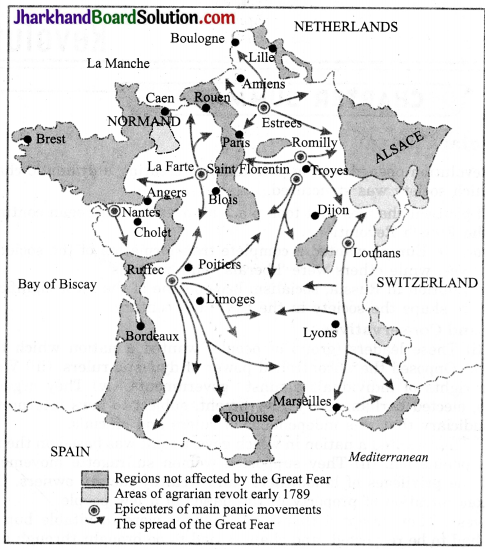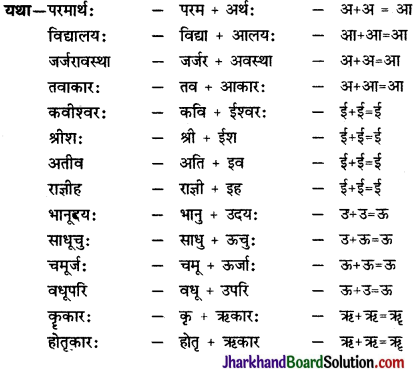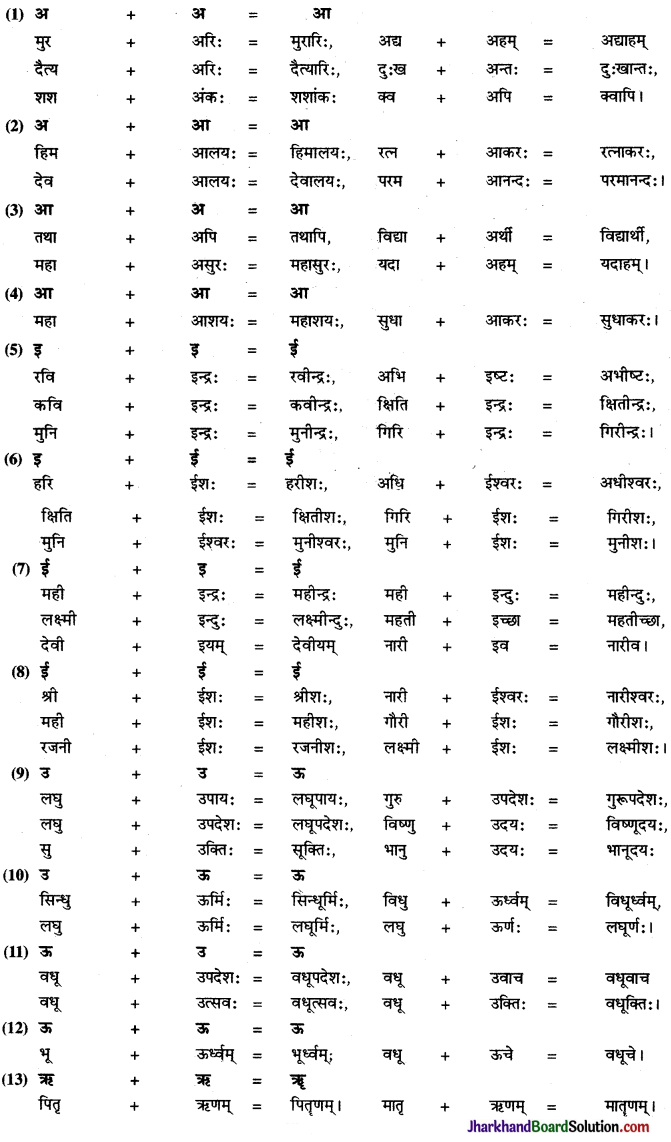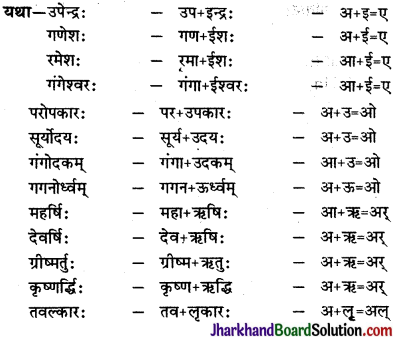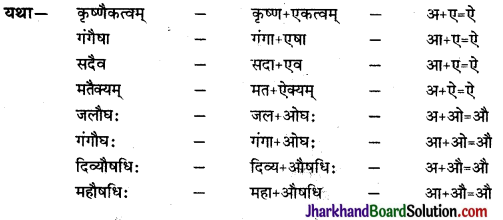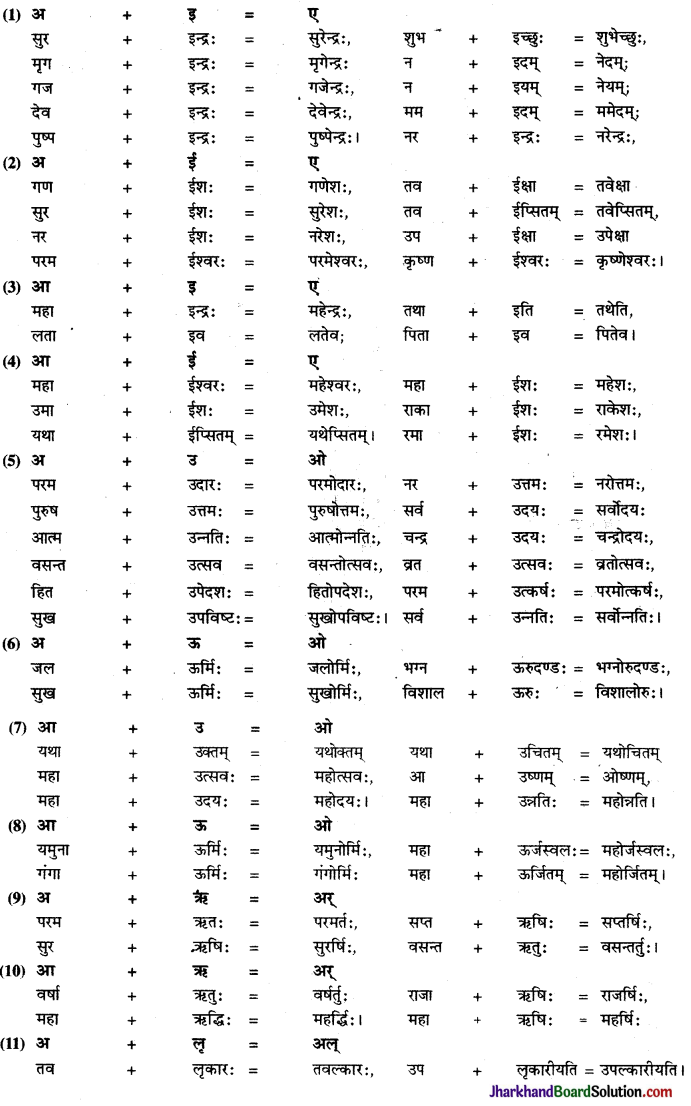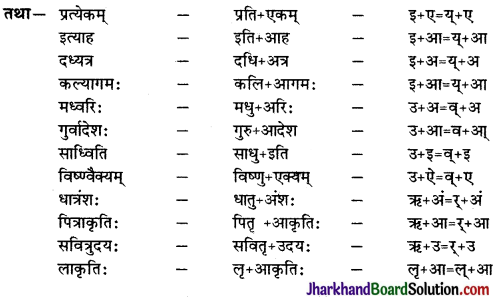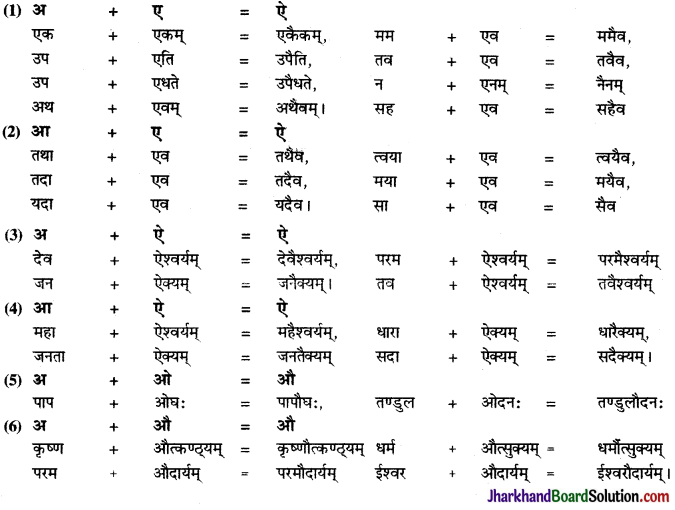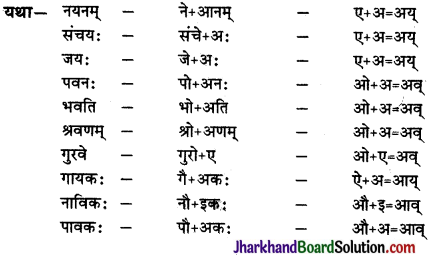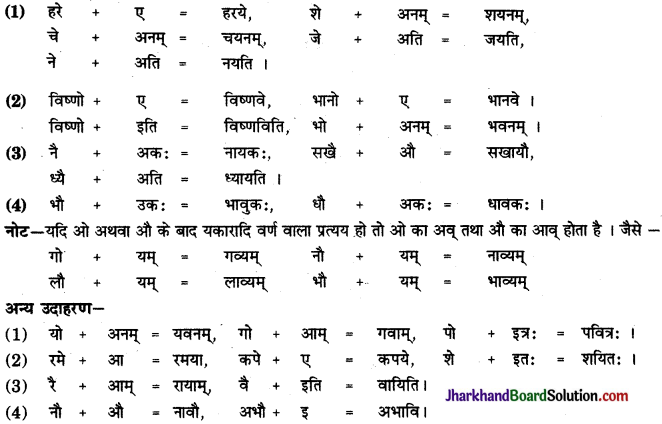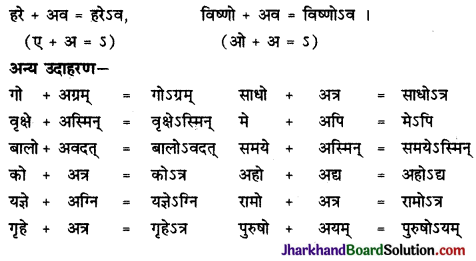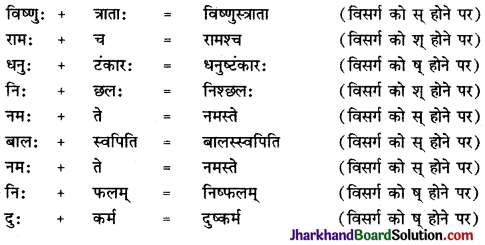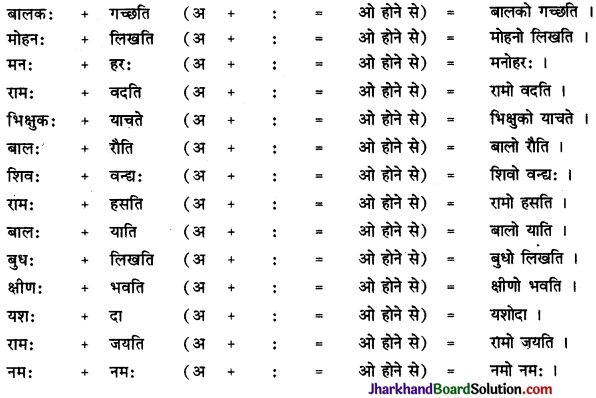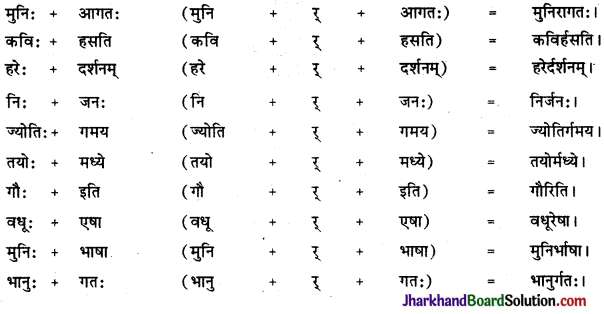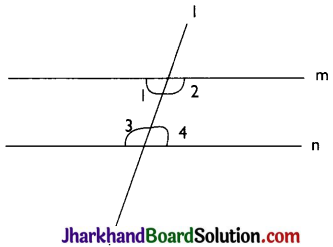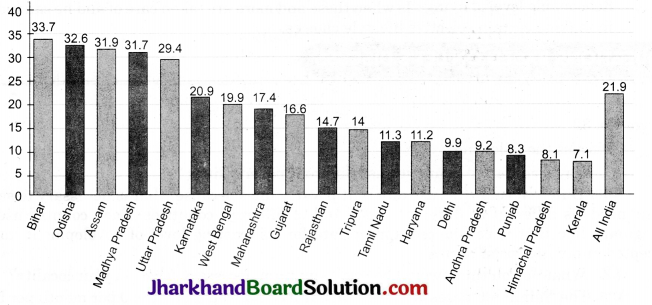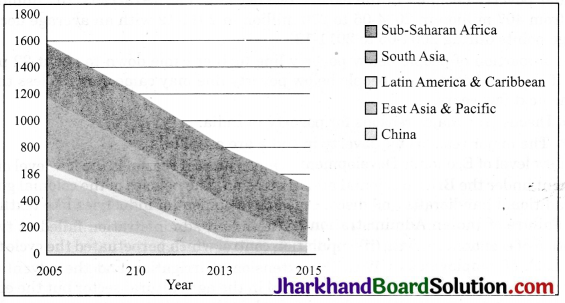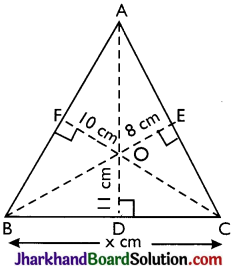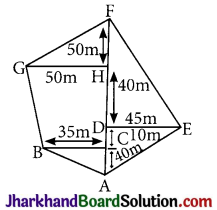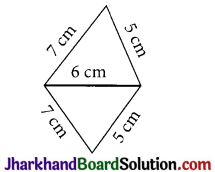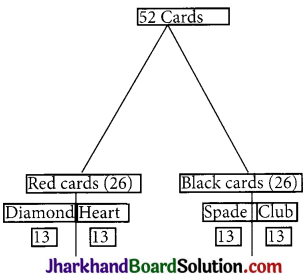Jharkhand Board JAC Class 10 Hindi Solutions Kshitij Chapter 15 स्त्री शिक्षा के विरोधी कुतर्कों का खंडन Textbook Exercise Questions and Answers.
JAC Board Class 10 Hindi Solutions Kshitij Chapter 15 स्त्री शिक्षा के विरोधी कुतर्कों का खंडन
JAC Class 10 Hindi स्त्री शिक्षा के विरोधी कुतर्कों का खंडन Textbook Questions and Answers
प्रश्न 1.
कुछ पुरातन पंथी लोग स्त्रियों की शिक्षा के विरोधी थे। द्विवेदी जी ने क्या-क्या तर्क देकर स्त्री-शिक्षा का समर्थन किया?
अथवा
महावीर प्रसाद द्विवेदी स्त्री शिक्षा का पुरजोर समर्थन करते हैं। उनके तर्कों का उल्लेख कीजिए।
उत्तर :
पढ़े-लिखे, सभ्य और स्वयं को सुसंस्कृत विचारों के समझने वाले लोग स्त्रियों की शिक्षा को समाज का अहित मानते हैं। उन लोगों ने अपने पास से कुछ कुतर्क दिए, जिन्हें द्विवेदी जी ने अपने सशक्त विचारों से काट दिया। द्विवेदी जी के अनुसार प्राचीन भारत में स्त्रियों के अनपढ़ होने का कोई स्पष्ट प्रमाण नहीं है, परंतु उनके पढ़े-लिखे होने के कई प्रमाण मिलते हैं।
उस समय बोलचाल की भाषा प्राकृत थी, तो नाटकों में भी स्त्रियों और अन्य पात्रों से प्राकृत तथा संस्कृत बुलवाई जाती थी। इसका यह अर्थ नहीं है कि उस समय स्त्रियाँ पढ़ी-लिखी नहीं थीं। हमारा प्राचीन साहित्य प्राकृत भाषा में ही है। उसे लिखने वाले अवश्य अनपढ़ होने चाहिए। बौद्ध धर्म और जैन धर्म के अधिकतर ग्रंथ प्राकृत भाषा में है, जो हमें उस समय के समाज से परिचित करवाते हैं। बुद्ध भगवान के सभी उपदेश प्राकृत भाषा में हैं। बौद्ध ग्रंथ त्रिपिटक प्राकृत भाषा में है।
जिस तरह आज हम बाँग्ला, हिंदी, उड़िया आदि भाषाओं का प्रयोग बोलने तथा पढ़ने-लिखने में करते हैं, उसी तरह उस समय के लोग प्राकृत भाषा का प्रयोग करते थे। यदि प्राकृत भाषा का प्रयोग करने से कोई अनपढ़ कहलाता है, तो आज के समय में सब पढ़े-लिखे लोग अनपढ़ होते। वाल्मीकि जी की : रामायण में तो बंदर तक संस्कृत बोलते थे, तो स्त्रियों के लिए कौन-सी भाषा उचित हो सकती है? यह बात स्त्री-शिक्षा का विरोध करने वाले स्वयं सोच सकते हैं।
ऋषि अत्रि की पत्नी, गार्गी तथा मंडन मिश्र की पत्नी ने अपने समय के बड़े प्रकांड आचार्यों को शास्त्रार्थ में मात दी थी, तो क्या वे पढ़ी-लिखी नहीं थीं? लेखक के अनुसार पुराने समय में उड़ने वाले विमानों का वर्णन शास्त्रों में मिलता है, परंतु किसी भी शास्त्र में उनके निर्माण की विधि नहीं मिलती; इससे क्या स्त्री-शिक्षा विरोधी उस समय विमान न होने से इन्कार कर सकते हैं? यदि शास्त्रों में स्त्री-शिक्षा का अलग से प्रबंध का कोई वर्णन नहीं मिलता, तो हम यह नहीं मान सकते हैं कि उस समय स्त्री-शिक्षा नहीं थी। उस समय स्त्रियों को पुरुषों के समान सभी अधिकार प्राप्त थे। इस प्रकार द्विवेदी जी अपने विचारों से स्त्री-शिक्षा के विरोधियों को उत्तर देते हैं।

प्रश्न 2.
‘स्त्रियों को पढ़ाने से अनर्थ होते हैं’-कुतर्कवादियों की इस दलील का खंडन द्विवेदी जी ने कैसे किया है? अपने शब्दों में लिखिए।
उत्तर :
स्त्री-शिक्षा विरोधी कुतर्कवादियों का यह कहना उचित नहीं है कि स्त्रियों को पढ़ाने से अनर्थ होता है। शकुंतला द्वारा अपने सम्मान की रक्षा के लिए कुछ कहना यदि अनर्थ है, तो यह उचित नहीं है। यदि पढ़ी-लिखी स्त्रियों का अपने सम्मान की रक्षा के लिए किया गया कार्य या विचार अनर्थ है, तो पुरुषों द्वारा किया गया अनर्थ भी उनकी पढ़ाई-लिखाई के कारण है। समाज को गलत मार्ग पर ले जाने का कार्य पुरुष ही करते हैं। डाके डालना, चोरी करना, घूस लेना, बुरे काम करना आदि पुरुष-बुद्धि की ही उपज है।
इसलिए सभी स्कूल-कॉलेज बंद कर देने चाहिए, जिससे पुरुष भी अनर्थ करने की शिक्षा न ले सकें। लेखक ने शकुंतला के दुष्यंत को कहे कटु वाक्यों को एक स्त्री के सम्मान की रक्षा के लिए प्रयुक्त किए गए वाक्य बताया है। सीता जी ने भी अपने परित्याग के समय राम जी पर आरोप लगाते हुए कहा था कि वह अपनी शुद्धता अग्नि में कूदकर सिद्ध कर चुकी थी। अब वह तो लोगों के कहने पर राम जी ने उनका परित्याग करके अपने कुल के नाम पर कलंक लगाया है। सीता जी का राम जी पर यह आरोप क्या उन्हें अशिक्षित सिद्ध करता है? वह महाविदुषी थी।
एक स्त्री का अपने सम्मान की रक्षा के लिए बोलना उचित है। यह पढ़-लिख कर अनर्थ करना नहीं है। अनर्थ पढ़ाईलिखाई की नहीं अपितु हमारी सोच की उपज है। स्त्रियों की पढ़ाई-लिखाई से समाज और घर में अनर्थ नहीं होता। पढ़ाई-लिखाई से स्त्रियों को अच्छे-बुरे का ज्ञान होता है और वे समाज की उन्नति में सहायक सिद्ध होती है।
प्रश्न 3.
दविवेदी जी ने स्त्री-शिक्षा विरोधी कुतर्कों का खंडन करने के लिए व्यंग्य का सहारा लिया है-जैसे ‘यह सब पापी पढ़ने का अपराध है। न वे पढ़तीं, न वे पूजनीय पुरुषों का मुकाबला करतीं।’ आप ऐसे अन्य अंशों को निबंध में से छाँटकर समझिए और लिखिए।
उत्तर :
द्विवेदी जी ने स्त्री-शिक्षा विरोधी कुतर्कों का खंडन करने के लिए निबंध में कई स्थानों पर व्यंग्य का सहारा लिया है। वे कहते हैं कि नाटकों में स्त्रियों का प्राकृत भाषा बोलना उनके अनपढ़ होने का प्रमाण नहीं है। इसके संदर्भ में उन्होंने कहा कि ‘वाल्मीकि रामायण के तो बंदर तक संस्कृत बोलते हैं। बंदर संस्कृत बोल सकते थे, स्त्रियाँ न बोल सकती थीं।’ यदि उस समय के जानवर तक संस्कृत भाषा का प्रयोग करते थे, तो स्त्रियाँ कैसे अनपढ़ हो सकती हैं? वे भी आम भाषा में संस्कृत ही बोलती होंगी।
जब हम उस समय उड़ने वाले जहाजों के वर्णन पर विश्वास करते हैं, तो इस बात पर विश्वास क्यों नहीं करते हैं कि उस समय स्त्री-शिक्षा दी जाती थी यदि उस समय की स्त्री-शिक्षा पर विश्वास नहीं है, तो ‘दिखाए, जहाज़ बनाने की नियमबद्ध प्रणाली के दर्शक ग्रंथ !’ स्त्री-शिक्षा विरोधियों के अनुसार स्त्रियों को पढ़ाना अनर्थ करना है। पढ़ी-लिखी स्त्रियाँ समाज और घर दोनों का नाश कर देंगी, इसलिए उनकी पढ़ाई उचित नहीं है। ऐसे पुरुषों के लिए द्विवेदी जी लिखते हैं स्त्री-शिक्षा पर अपना विरोध प्रकट कर लोग देश के गौरव को बढ़ा नहीं कम कर रहे हैं।
उनके अनुसार पढ़ना-लिखना पुरुषों के लिए उचित है, लेकिन स्त्री के लिए इस विषय में सोचना भी विष के समान है। ‘स्त्रियों के लिए पढ़ना कालकूट और पुरुषों के लिए पीयूष का घूट !’ अपने सम्मान की रक्षा के लिए स्त्री द्वारा पुरुष को यदि कटु वाक्य बोल भी दिए गए हों, तो यह अनर्थ नहीं है; सभी को अपने सम्मान की रक्षा करनी चाहिए। स्त्री-शिक्षा विरोधियों के अनुसार शकुंतला द्वारा दुष्यंत के कार्य का विरोध करना कटु वाक्य थे।
यह उसकी पढ़ाई-लिखाई का परिणाम है, तो क्या वह यह कहती”आर्य पुत्र, शाबाश ! बड़ा अच्छा काम किया जो मेरे साथ गांधर्व-विवाह करके मुकर गए। नीति, न्याय, सदाचार और धर्म की आप प्रत्यक्ष मूर्ति हैं।” इस प्रकार निबंध में द्विवेदी जी ने स्त्री-शिक्षा के विरोधी की बात काटने के लिए व्यंग्य का सहारा लिया है, जिससे उनकी बात सशक्त ढंग से दूसरों पर अपना प्रभाव छोड़ती है।

प्रश्न 4.
पुराने समय में स्त्रियों द्वारा प्राकृत भाषा में बोलना क्या उनके अनपढ़ होने का सबूत है-पाठ के आधार पर स्पष्ट कीजिए।
उत्तर :
पुराने समय में स्त्रियों द्वारा प्राकृत भाषा में बोलना उनके अनपढ़ होने का सबूत नहीं है। उस समय आम बोलचाल और पढ़ने-लिखने की भाषा प्राकृत थी। जिस प्रकार आज हम हिंदी, बाँग्ला, मराठी आदि भाषाओं का प्रयोग बोलने, पढ़ने व लिखने के लिए करके स्वयं को पढ़ा-लिखा, सुसभ्य और सुसंस्कृत बताते हैं; उसी प्रकार प्राचीन समय में प्राकृत भाषा का विशेष महत्व था। हमारा प्राचीन साहित्य स्पष्ट प्राकृत भाषा में है और उसी साहित्य से हमें तत्कालीन समाज का वर्णन मिलता है। इसलिए हम प्राकृत भाषा में बोलने वाली स्त्रियों को अनपढ़ नहीं कह सकते।
प्रश्न 5.
परंपरा के उन्हीं पक्षों को स्वीकार किया जाना चाहिए जो स्त्री-पुरुष समानता को बढ़ाते हों-तर्क सहित उत्तर दीजिए।
उत्तर :
लेखक का यह कथन स्वीकार करने योग्य है कि हमें परंपरा के उन्हीं पक्षों को अपनाना चाहिए, जो स्त्री-पुरुष की समानता को बढ़ाते हों। मनुष्य का जीवन अकेले नहीं चल सकता। उसकी जीवन-यात्रा स्त्री-पुरुष के सहयोग से ही चलती है। यदि जीवनरूपी गाड़ी का एक पहिया मज़बूत और दूसरा कमज़ोर होगा, तो गाड़ी ठीक से नहीं चल पाएगी। इसलिए दोनों को ही जीवनरूपी गाड़ी को सुचारु रूप से चलाने के लिए समान रूप से योग्य बनना चाहिए।
यह तभी संभव हो सकता है, जब दोनों को शिक्षा, खान-पान, मान-सम्मान के समान अवसर प्रदान किए जाए। घरों में लड़के के जन्म पर खुशियाँ और लड़की के जन्म पर मातम नहीं मनाना चाहिए। लड़की की भ्रूण-हत्या बंद होनी चाहिए। संसार में जैसे लड़के के आने का स्वागत होता है, वैसे ही लड़की के जन्म पर भी होना चाहिए। जब तक हम लड़की-लड़के के भेद को समाप्त करके दोनों को समान रूप से नहीं अपनाते, भविष्य में उनकी जीवन गाड़ी भी ठीक से नहीं चल सकती। इसलिए हमें अपनी उन्हीं परंपराओं को अपनाना चाहिए, जिनमें स्त्री-पुरुष की समानता की प्रतिष्ठा हो।
प्रश्न 6.
तब की शिक्षा-प्रणाली और अब की शिक्षा-प्रणाली में क्या अंतर है? स्पष्ट करें।
उत्तर :
पुराने ज़माने में लोग स्त्रियों को शिक्षा देने के विरोधी थे। वे स्त्रियों को पढ़ाने से अनर्थ होना मानते थे। धीरे-धीरे लोगों ने शिक्षा का महत्व समझा और स्त्रियों को भी पढ़ाने लगे। स्कूल-कॉलेजों में शिक्षा के नाम पर परंपरागत रूप से पढ़ाए जाने वाले विषय ही पढ़ाए जाते थे। अब शिक्षा-प्रणाली में व्यापक परिवर्तन आ गया है। विद्यार्थियों को परंपरागत शिक्षा के साथ-साथ रोज़गारोन्मुख विषय भी पढ़ाए जाते हैं, जिससे वे अपनी शिक्षा समाप्त करने के बाद स्वयं को किसी व्यवसाय अथवा कार्य में लगाकर आजीविका अर्जित कर सकें। स्त्रियाँ भी पढ़-लिखकर कुशल गृहस्थ जीवन व्यतीत करने के साथ ही समाज एवं देश के लिए अनेक उपयोगी कार्य भी कर रही हैं।
रचना और अभिव्यक्ति –
प्रश्न 7.
महावीरप्रसाद द्विवेदी का निबंध उनकी दूरगामी और खुली सोच का परिचायक है, कैसे ?
उत्तर :
महावीरप्रसाद दविवेदी का निबंध उनकी दूरगामी और खुली सोच का परिचायक है। दविवेदी जी के अनुसार प्राचीन समय की अपेक्षा आधुनिक समय में स्त्री-शिक्षा का अधिक महत्व है। द्विवेदी जी का समय समाज में नई चेतना जागृत करने का था। उस समय के समाज में स्त्रियों को पढ़ाना अपराध समझा जाता था। पढ़ी-लिखी स्त्रियों को अच्छी दृष्टि से नहीं देखा जाता था। दकियानूसी विचारों वाले लोगों ने स्त्री-शिक्षा के विरोध में व्यर्थ की दलीलें बना रखी थीं।
द्विवेदी जी ने स्त्री-शिक्षा के महत्व को समझा और उसका प्रचार-प्रसार करने के लिए लेखों का सहारा लिया। उनका मानना था कि शिक्षा ही देश का उचित विकास कर सकती है। स्त्रियों के उत्थान से देश का उत्थान निश्चित है। शिक्षित नारी स्वयं का भला तो करती है साथ में अपने परिवार, समाज और देश का भी भला करती है। नारी की क्षमता और प्रतिभा के उचित उपयोग के लिए उसे शिक्षित करना आवश्यक है।
द्विवेदी जी की स्त्री-शिक्षा के प्रति यह सोच आज के समय में वरदान सिद्ध हो रही है। आधुनिक समय में शिक्षा का बहुत महत्व है। इसके बिना मानव-जीवन के अस्तित्व की कल्पना भी नहीं की जा सकती। आज के समय में लड़कों और लड़कियों के लिए शिक्षा अनिवार्य है। घर, समाज और देश के विकास के लिए नारी का आत्मनिर्भर होना आवश्यक है। इसलिए आज हर क्षेत्र में लड़कियाँ लड़कों से आगे निकल रही हैं। हर क्षेत्र में लड़कियों की सफलता का श्रेय उन लोगों को है, जिन्होंने स्त्री-शिक्षा के लिए लंबा संघर्ष किया। उन लोगों ने आने वाले समय में स्त्री-शिक्षा के महत्व को समझा तथा स्त्री-शिक्षा विरोधियों की विचारधारा का डटकर मुकाबला किया।

प्रश्न 8.
द्विवेदी जी की भाषा-शैली पर एक अनुच्छेद लिखिए।
उत्तर :
द्विवेदी जी की भाषा शुद्ध खड़ी बोली हिंदी हैं, जिसमें उन्होंने ‘प्रगल्भ, पीयूष, कटु, उद्धत, सहधर्मचारिणी, पांडित्य, दुर्वाक्य’ जैसे तत्सम प्रधान शब्दों के साथ-साथ ‘मुमानियत, हरगिज़, गंवार, अपढ़, बम, सबूत, तिस, लवलैटर’ जैसे विदेशी, देशज तथा तद्भव शब्दों का भरपूर प्रयोग किया है। ‘छक्के छुड़ाना’ जैसे मुहावरों के प्रयोग ने भापा में सजीवता ला दी है। लेखक की शैली वर्णन प्रधान, भावपूर्ण एवं व्याख्यात्मक होते हुए भी व्यंग्य प्रधान है; जैसे -‘अत्रि की पत्नी पत्नी-धर्म पर व्याख्यान देते समय घंटों पांडित्य प्रकट करे, गार्गी बड़े-बड़े ब्रहमवादियों को हरा दे, मंडन मिश्र की सहधर्मचारिणी शंकराचार्य के छक्के छुड़ा दे ! गज़ब ! इससे भयंकर बात क्या हो सकेगी। यहृ सब दुराचार स्त्रियों को पढ़ाने ही का कुफल है। समझे। इस प्रकार लेखक ने अत्यंत सहज तथा रोचक भाषा-शैली का प्रयोग करते हुए अपने विषय का प्रतिपादन किया है।
भाषा-अध्ययन –
प्रश्न 9.
निम्नलिखित अनेकार्थी शब्दों को ऐसे वाक्यों में प्रयुक्त कीजिए जिनमें उनके एकाधिक अर्थ स्पष्ट हों –
चाल, दल, पत्र, हरा, पर, फल, कुल
उत्तर :
(क) चाल – रमा का चाल-चलन ठीक नहीं है।
चाल – हिरण तेज़ चाल से दौड़ता हैं।
(ख) दल – टिइ्डी-दल ने गेहूँ की तैयार फसल खराब कर दी।
दल – सभी राजनीतिक दल चुनाव में सक्रिय हैं।
(ग) पत्र – आज श्याम का पत्र आया है।
पत्र – प्राचीन समय में लोग पत्र पर लिखा करते थे।
(घ) हरा – शुभम ने पराग को कुश्ती में हरा दिया।
हरा – झंडे में हरा रंग देश में हरियाली का प्रतीक है।
(ङ) पर – तितली के पर पीले रंग के हैं।
पर – कल पर कभी काम नहीं छोड़ना चाहिए।
(च) फल – आज दसर्वं कक्षा का परीक्षा-फल आएगा।
फल – स्वस्थ रहने के लिए प्रतिदिन फल का सेवन करना चाहिए।
(छ) कुल – आजकल लड़कियाँ लड़कों से अधिक अपने कुल का नाम रोशन कर रही हैं।
कुल – राम ने नर्बी परीक्षा में कुल कितने अंक प्राप्त किए ?
पाठेतर सक्रियता –
प्रश्न 1.
अपनी दादी, नानी और माँ से बातचीत कीजिए और (स्त्री-शिक्षा संबंधी) उस समय की स्थितियों का पता लगाइए और अपनी स्थितियों से तुलना करते हुए निबंध लिखिए। चाहें तो उसके साथ तसर्वरं भी चिपकाइए।
उत्तर :
‘शिक्षा’ से अभिप्राय सीखना है। मनुष्य जीवनभर कुछ-न-कुछ सीखता रहता है। इसी सीखने के अंतर्गत पढ़ाई-लिखाई भी आती है। पढ़ाई-लिखाई के बिना मानव का जीवन पशु के समान होता है। इसलिए पढ़ाई-लिखाई का मानव के जीवन में बहुत महत्व है। प्राचीन समय में पढ़ाई-लिखाई का संबंध लड़कों तक सीमित माना जाता था, उसमें लड़कियों को नहीं के बराबर स्थान दिया जाता था। लड़कियों को इतनी शिक्षा दी जाती थी, जिससे वे केवल धर्म का पालन करना सीख सकें। अधिक शिक्षा लड़कियों के लिए अभिशाप समझी जाती थी।
लड़कियों को बचपन से ही घर सँभालने की शिक्षा दी जाती थी। उन्हें समझा दिया जाता था कि उनका कार्यक्षेत्र घर की चारदीवारी तक सीमित है, इसलिए उनके लिए अधिक शिक्षा महत्व नर्हीं रखती। उस समय लड़कियों के लिए अलग से पाठशालाएँ भी नहीं होती थीं। उस समय यदि किसी परिवार में शिक्षा के महत्व को समझकर लड़कियों को पढ़ा-लिखा दिया जाता था, तो उस परिवार की लड़कियों को अच्छी नज़रों से नहीं देखा जाता था। पढ़ाई-लिखाई लड़कियों को बिगाड़ने का साधन समझा जाता था।
लेकिन आज परिस्थितियाँ कुछ और हैं। आज के समय में लड़कों के समान लड़कियों के लिए भी पढ़ाई-लिखाई अनिवार्य है। आज के समय में लड़कियों को पढ़ाना उन्हें बिगाड़ने का साधन नहीं माना जाता अपितु उन्हें पढ़ाकर उनका भविष्य सुरक्षित किया जाता है। आधुनिक युग में लड़कियाँ हर क्षेत्र में लड़कों के साथ कदम-से-कदम मिलाकर चल रही हैं। सरकार, समाज और घर-परिवार में सभी लोग शिक्षा के महत्व को समझ गए हैं। शिक्षा ही देश की उन्नति में सहायक हैं। जब देश की नारी शिक्षित होगी, तभी हर घर शिक्षित होगा और वह देश के विकास में अपना सहयोग देगा।
लड़कियों को पढ़ाने के लिए सरकार ने भी कई तरह की योजनाएँ आरंभ की हैं। कई क्षेत्रों में लड़कियों को मुफ्त में शिक्षा दी जाती है। शहरों और गाँवों में लड़कियों के लिए अलग से पाठशालाएँ व कॉलेज खुले हुए हैं। आज की लड़कियाँ हर क्षेत्र में अपने पाँव जमा चुकी हैं। उन्होंने अपनी क्षमता को साबित किया है। आज की नारी अबला नहीं सबला है।

प्रश्न 2.
लड़कियों की शिक्षा के प्रति परिवार और समाज में जागरूकता आए-इसके लिए आप क्या-क्या करेंगे?
उत्तर :
अभी भी कई स्थानों पर लड़कियों की शिक्षा को अनिवार्य नहीं माना जाता। आज भी कई परिवारों में लड़कियों की शिक्षा को लड़कों की अपेक्षा कम महत्व दिया जाता है। उन्हें घर पर एक बोझ के रूप में देखा जाता है, जिसे माँ-बाप उसकी शादी करके उतारना चाहते हैं। ऐसे लोगों को लड़कियों की शिक्षा के महत्व को समझाने के लिए जगह-जगह नुक्कड़ नाटक होने चाहिए। नुक्कड़ नाटकों में लड़कियों के लिए शिक्षा क्यों अनिवार्य है, दिखाना चाहिए।
लड़कियों और लड़कों में कोई अंतर नहीं होता, लोगों में इस सोच को बढ़ावा देना चाहिए। लड़कियाँ माँ-बाप पर बोझ नहीं होती अपितु पढ़-लिखकर वे अपने माता-पिता की ज़िम्मेदारियों का बोझ हल्का करती हैं। यदि लड़कियाँ पढ़-लिखकर आत्मनिर्भर हो जाए, तो दहेज जैसी कुप्रथा स्वयं ही दूर हो जाएँगी। पढ़-लिखकर लड़कियों में अच्छे-बुरे की समझ आ जाती है। वे समाज में फैली हर कुरीति का डटकर सामना कर सकती हैं तथा माता-पिता का नाम रोशन कर सकती हैं। परिवार, समाज तथा देश की उन्नति में लड़कियाँ लड़कों से अधिक सहायक होती हैं। शिक्षित लड़कियाँ ही परिवार और समाज को शिक्षित बनाती हैं और उन्हें देश की प्रगति में सहायक होने के लिए प्रेरित करती हैं।
प्रश्न 3.
स्त्री-शिक्षा पर एक पोस्टर तैयार कीजिए।
उत्तर :
विद्यार्थी इन कार्यों को अपने अध्यापक/अध्यापिका की सहायता से करें।
प्रश्न 4.
स्त्री-शिक्षा पर एक नुक्कड़ नाटक तैयार कर उसे प्रस्तुत कीजिए।
उत्तर :
विद्यार्थी इन कार्यों को अपने अध्यापक/अध्यापिका की सहायता से करें।
यह भी जानें –
भवभूति – संस्कृत के प्रधान नाटककार हैं। इनके तीन प्रसिद्ध ग्रंथ वीररचित, उत्तररामचरित और मालतीमाधव हैं। भवभूति करुण रस के प्रमुख लेखक थे।
विश्ववरा – अत्रिगोत्र की स्त्री। ये ऋगवेद के पाँचवें मंडल 28वें सूक्त की एक में से छठी ऋक् की ऋषि थीं।
शीला – कौरिडन्य मुनि की पत्नी का नाम।
थेरीगाथा – बौद्ध भिक्षुणियों की पद्य रचना इसमें संकलित है।
अनुसूया – अत्रि मुनि की पत्नी और दक्ष प्रजापति की कन्या।
गार्गी – वैदिक समय की एक पंडिता ऋषिपुत्री। इनके पिता का नाम गर्ग मुनि था। मिथिला के जनकराज की सभा में इन्होंने पंडितों के सामने याज्ञवल्क्य के साथ वेदांत शास्त्र विषय पर शास्त्रार्थ किया था।
गाथा सप्तशती – प्राकृत भाषा का ग्रंथ जिसे हाल द्वारा रचित माना जाता है।
कुमारपाल चरित्र – एक ऐतिहासिक ग्रंथ है जिसे वीं शताब्दी के अंत में अज्ञातनामा कवि ने अनहल के राजा कुमारपाल के लिए लिखा था। इसमें ब्रह्मा से लेकर राजा कुमारपाल तक बौद्ध राजाओं की वंशावली का वर्णन है।
त्रिपिटक ग्रंथ – गौतम बुद्ध ने भिक्षु-भिक्षुणियों को अपने सारे उपदेश मौखिक दिए थे। उन आदेशों को उनके शिष्यों ने कंठस्थ कर लिया था और बाद में उन्हें त्रिपिटक के रूप में लेखबद्ध किया गया। वे तीन त्रिपिटक हैं-सुत या सूत्र पिटक, विनय पिटक और अभिधम पिटक।
शाक्य मुनि – शक्यवंशीय होने के कारण गौतम बुद्ध को शाक्य मुनि भी कहा जाता है।
नाट्यशास्त्र – भरतमुनि रचित काव्यशास्त्र संबंधी संस्कृत के इस ग्रंथ में मुख्यतः रूपक (नाटक) का शास्त्रीय विवेचन किया गया है। इसकी रचना 300 ईसा पूर्व मानी जाती है।
कालिदास – संस्कृत के महान कवियों में कालिदास की गणना की जाती है। उन्होंने कुमारसंभव, रघुवंश (महाकाव्य), ऋतु संहार, मेघदूत (खंडकाव्य), विक्रमोर्वशीय, मालविकाग्निमित्र और अभिज्ञान शाकुंतलम् (नाटक) की रचना की।
आज़ादी के आंदोलन से सक्रिय रूप से जुड़ी पंडिता रमाबाई ने स्त्रियों की शिक्षा एवं उनके शोषण के विरुद्ध जो आवाज़ उठाई उसकी एक झलक यहाँ प्रस्तुत है। आप ऐसे अन्य लोगों के योगदान के बारे में पढ़िए और मित्रों से चर्चा कीजिए। भारतीय राष्ट्रीय कांग्रेस का पाँचवाँ अधिवेशन 1889 में मुंबई में आयोजित हुआ था। खचाखच भरे हॉल में देशभर के नेता एकत्र हुए थे। एक सुंदर युवती अधिवेशन को संबोधित करने के लिए उठी। उसकी आँखों में तेज़ और उसके कांतिमय चेहरे पर प्रतिभा झलक रही थी। इससे पहले कांग्रेस अधिवेशनों में ऐसा दृश्य देखने में नहीं आया था।
हॉल में लाउडस्पीकर न थे। पीछे बैठे हुए लोग उस युवती की आवाज़ नहीं सुन पा रहे थे। वे आगे की ओर बढ़ने लगे। यह देखकर युवती ने कहा, “भाइयो, मुझे क्षमा कीजिए। मेरी आवाज़ आप तक नहीं पहुंच पा रही है। लेकिन इस पर मुझे आश्चर्य नहीं है। क्या आपने शताब्दियों तक कभी किसी महिला की आवाज़ सुनने की कोशिश की? क्या आपने उसे इतनी शक्ति प्रदान की कि वह अपनी आवाज़ को आप तक पहुँचने योग्य बना सके?”
प्रतिनिधियों के पास इन प्रश्नों के उत्तर न थे। इस साहसी युवती को अभी और बहुत कुछ कहना था। उसका नाम पंडिता रमाबाई था। उस दिन तक स्त्रियों ने कांग्रेस के अधिवेशनों में शायद ही कभी भाग लिया हो। पंडिता रमाबाई के प्रयास से 1889 के उस अधिवेशन में 9 महिला प्रतिनिधि सम्मिलित हुई थीं। वे एक मूक प्रतिनिधि नहीं बन सकती थीं। विधवाओं को सिर मुंडवाए जाने की प्रथा के विरोध में रखे गए प्रस्ताव पर उन्होंने एक ज़ोरदार भाषण दिया।
“आप पुरुष लोग ब्रिटिश संसद में प्रतिनिधित्व की माँग कर रहे हैं जिससे कि आप भारतीय जनता की राय वहाँ पर अभिव्यक्त कर सकें। इस पांडाल में अभिव्यक्ति की स्वतंत्रता के लिए चीख-चिल्ला रहे हैं, तब आप अपने परिवारों में वैसी ही स्वतंत्रता महिलाओं को क्यों नहीं देते? आप किसी महिला को उसके विधवा होते ही कुरूप और दूसरे पर निर्भर होने के लिए क्यों विवश करते हैं? क्या कोई विधुर भी वैसा करता है? उसे अपनी इच्छा के अनुसार जीने की स्वतंत्रता है। तब स्त्रियों को वैसी स्वतंत्रता क्यों नहीं मिलती?”
निश्चित रूप से कहा जा सकता है कि पंडिता रमाबाई ने भारत में नारी-मुक्ति आंदोलन की नींव डाली।
वे बचपन से ही अन्याय सहन नहीं कर पाती थीं। एक दिन उन्होंने नौ वर्ष की एक छोटी-सी लड़की को उसके पति के शव के साथ भस्म किए जाने से बचाने की चेष्टा की। “यदि स्त्री के लिए भस्म होकर सती बनना अनिवार्य है तो क्या पुरुष भी पत्नी की मृत्यु के बाद सता होते हैं?” रौबपूर्वक पूछे गए इस प्रश्न का उस लड़की की माँ के पास कोई उत्तर न था। उसने केवल इतना कहा कि “यह पुरुषों की दुनिया है।
कानून वे ही बनाते हैं, स्त्रियों को तो उनका पालन भर करना होता है।” रमाबाई ने पलटकर पूछा, “स्त्रियाँ ऐसे कानूनों को सहन क्यों करती हैं? मैं जब बड़ी हो जाऊँगी तो ऐसे कानूनों के विरुद्ध संघर्ष करूँगी।” सचमुच उन्होंने पुरुषों द्वारा महिलाओं के प्रत्येक प्रकार के शोषण के विरुद्ध संघर्ष किया।
JAC Class 10 Hindi स्त्री शिक्षा के विरोधी कुतर्कों का खंडन Important Questions and Answers
प्रश्न 1.
स्त्री-शिक्षा के विरोधी अपने दल में क्या-क्या तर्क देते हैं ? दो का उल्लेख कीजिए।
उत्तर :
स्त्री-शिक्षा विरोधियों ने स्त्री-शिक्षा के विरोध में निम्नलिखित तर्क दिए हैं –
(क) प्राचीन काल में संस्कृत-कवियों ने नाटकों में स्त्रियों से अनपढ़ों की भाषा में बातें करवाई हैं। इससे पता चलता है कि उस समय स्त्रियों को पढ़ाने का चलन नहीं था।
(ख) स्त्रियों को पढ़ाने से अनर्थ होता है।
(ग) स्त्रियों को पढ़ाना समय बर्बाद करना है।
(घ) शकुंतला का दुष्यंत को भला-बुरा कहना उसकी पढ़ाई-लिखाई का दोष था।

प्रश्न 2.
लेखक नाटकों में स्त्रियों की भाषा प्राकृत होने को उनकी अशिक्षा का प्रमाण नहीं मानता। इसके लिए वह क्या तर्क देता है ?
उत्तर :
स्त्री-शिक्षा विरोधियों के अनुसार प्राचीन काल में स्त्रियों से नाटक में अनपढ़ों की भाषा का प्रयोग करवाया जाता था। द्विवेदी जी के अनुसार नाटकों में प्राकृत भाषा बोलना अनपढ़ता का प्रमाण नहीं है। उस समय आम बोलचाल में प्राकृत भाषा का प्रयोग किया : जाता था। संस्कृत भाषा का चलन तो कुछ लोगों तक ही सीमित था। इसलिए आचार्यों ने नाट्यशास्त्रों से संबंधित नियम बनाते समय इस बात का ध्यान रखा होगा कि कुछ चुने लोगों को छोड़कर अन्यों से उस समय की प्रचलित प्राकृत भाषा में संवाद बोलने के लिए कहा जाए। इससे स्त्रियों की अनपढ़ता सिद्ध नहीं होती।
प्रश्न 3.
प्राचीन समय में प्राकृत भाषा का चलन था। इसके लिए द्विवेदी जी ने क्या प्रमाण दिया है?
उत्तर :
स्त्री-शिक्षा विरोधियों ने प्राकृत भाषा को अनपढ़ों की भाषा कहा है। द्विवेदी जी के अनुसार उस समय की बोलचाल और पढ़ाई-लिखाई की भाषा प्राकृत थी। उस समय में प्राकृत भाषा के चलन का प्रमाण बौद्ध-ग्रंथों और जैन-ग्रंथों से मिलता है। दोनों धर्मों के हज़ारों ग्रंथ प्राकृत भाषा में लिखे गए हैं। बुद्ध भगवान ने अपने उपदेश उस समय की प्रचलित प्राकृत भाषा में दिए हैं। बौद्धों के सबसे बड़े ग्रंथ त्रिपिटक की रचना भी प्राकृत भाषा में की गई है। इसका एकमात्र कारण यह था कि उस समय बोलचाल की भाषा प्राकृत थी। इससे सिद्ध होता है कि प्राकृत अनपढ़ों की भाषा नहीं है।
प्रश्न 4.
द्विवेदी जी ने प्राकृत भाषा की तुलना आज की कौन-सी भाषा से की है और क्यों?
उत्तर :
द्विवेदी जी ने प्राकृत भाषा की तुलना आज अत्यधिक बोले जाने वाली भाषा हिंदी से की है। स्त्री-शिक्षा विरोधियों ने प्राचीन समय में बोली जाने वाली प्राकृत भाषा को अनपढ़ों और गँवारों की भाषा बताया है। लेकिन द्विवेदी जी के अनुसार प्राकृत भाषा उस समय की आम बोलचाल की भाषा थी, इसलिए प्राकृत बोलना और पढ़ना-लिखना अनपढ़ता का कारण नहीं है।
उस समय के प्रसिद्ध ग्रंथ प्राकृत भाषा में लिखे गए थे; जैसे-गाथा-सप्तशती, सेतुबंध, महाकाव्य, कुमारपाल चरित आदि। यदि इन ग्रंथों को लिखने वाले अनपढ़ और गँवार हैं, तो आज के समय में हिंदी के प्रसिद्ध से प्रसिद्ध संपादकों को अनपढ़ और गँवार कहा जा सकता है। हिंदी इस समय की आम बोलचाल की भाषा है। जिस तरह हम लोग हिंदी, बाँग्ला आदि भाषाओं को पढ़कर विद्वान बन सकते हैं, उसी तरह प्राचीन समय में शौरसेनी, मागधी, महाराष्ट्री आदि प्राकृत भाषाओं को पढ़-लिखकर कोई भी सभ्य, शिक्षित और पंडित बन सकते थे।

प्रश्न 5.
लेखक ने अपनी बात सिद्ध करने के लिए कौन-कौन सी प्रसिद्ध विदुषी स्त्री का वर्णन किया है?
उत्तर :
लेखक ने स्त्री-शिक्षा विरोधियों की व्यर्थ दलीलों को निराधार सिद्ध करते हुए लिखा है कि प्राचीन समय में भी स्त्रियों को पढ़ाया लिखाया जाता था। यह बात सही है कि उनके लिए अलग से विश्वविद्यालय नहीं थे, परंतु यह कहना सही नहीं है कि प्राचीन समय में स्त्रियों को शिक्षित नहीं किया जाता था। वेदों को हिंदू ईश्वर-कृत रचना मानते हैं; ईश्वर ने भी वेदों की रचना और दर्शन का निर्माण स्त्रियों से करवाया है। शीला और विज्जा जैसी विदुषी स्त्रियों को बड़े-बड़े पुरुष-कवियों ने सम्मानित किया था।
उनकी कविता के नमूने शाग्र्धर-पद्धति में देखे जा सकते हैं। अत्रि की पत्नी पत्नी-धर्म पर कई घंटे लगातार उपदेश दे सकती थी। गार्गी ने बड़े-बड़े वेद पढ़नेपढ़ाने वालों को अपने पांडित्य से हरा दिया था। मंडन मिश्र की पत्नी ने शंकराचार्य को अपने ज्ञान से पराजित कर दिया था। बौद्ध ग्रंथ त्रिपिटक के अंतर्गत थेरीगाथा में स्त्रियों द्वारा रचित सैकड़ों पद्य-रचनाएँ हैं। इसलिए हम यह नहीं कह सकते कि प्राचीन समय में स्त्रियों को शिक्षित करने का नियम नहीं था, अपितु उस समय स्त्रियों को पुरुषों के समान अधिकार प्राप्त थे।
प्रश्न 6.
वर्तमान में स्त्रियों का पढ़ना क्यों ज़रूरी माना गया है, स्पष्ट कीजिए।
उत्तर :
लेखक के अनुसार यह मान भी लिया जाए कि प्राचीन समय में स्त्रियों को पढ़ाने का चलन नहीं था, तो उस समय स्त्री-शिक्षा की आवश्यकता इतनी अधिक नहीं होगी। परंतु आधुनिक समय में स्त्री-शिक्षा का महत्व बहुत अधिक है। आधुनिक युग भौतिकवादी युग है। इस युग में अनपढ़ता देश के विकास में बाधा उत्पन्न करती है। यदि नारी शिक्षित होगी, तो वह अपने परिवार के सदस्यों को शिक्षित करने का प्रयत्न करेगी और उन्हें अच्छे-बुरे का ज्ञान करवाकर एक अच्छा नागरिक बनने के लिए प्रेरित करेगी। परिवार शिक्षित होगा तो समाज में भी नई विचारधारा का विकास होगा, जिससे देश का विकास होगा। इसलिए लेखक ने प्राचीन समय की अपेक्षा आधुनिक समय में स्त्रियों के लिए शिक्षा को अनिवार्य कहा है।
प्रश्न 7.
द्विवेदी जी का निबंध क्या संदेश देता है ?
उत्तर :
द्विवेदी जी ने अपने निबंध के माध्यम से स्त्री-शिक्षा का विरोध करने वालों पर कड़ा प्रहार किया है। स्त्री-शिक्षा विरोधियों के अनुसार लड़कियों को पढ़ाना अनर्थ करना है। परंतु द्विवेदी जी ने आज के समय की आवश्यकता को समझते हुए स्त्री-शिक्षा पर बल दिया है। उनके अनुसार स्त्रियों को शिक्षित करने से ही समाज और देश का भविष्य उज्ज्वल हो सकता है।
शिक्षा से व्यक्ति बिगड़ता नहीं है अपितु उसे अच्छे-बुरे की समझ आ जाती है। इस देश की वर्तमान शिक्षा प्रणाली में दोष हैं; इसलिए उस शिक्षा प्रणाली को सुधारने की आवश्यकता है, जिसमें लड़कियों के लिए विशेष रूप से शिक्षा का प्रबंध हो। लड़कियों को पढ़ाने से कई प्रकार की समस्याओं से छुटकारा मिल सकता है। लड़कियों को पढ़-लिखकर आत्मनिर्भर बनने की प्रेरणा देनी चाहिए।
लड़कियों के आत्मनिर्भर होने पर दहेज जैसी कुप्रथा का अंत हो जाएगा। द्विवेदी जी का निबंध यह भी संदेश देता है कि परंपराओं का पालन पुराने नियमों के अनुसार नहीं करना चाहिए; जहाँ आवश्यकता हो, वहाँ अपने विवेक से निर्णय लेना चाहिए। जो बात वर्तमान समय के लिए उपयोगी है, उसे मान लेना चाहिए और समाज के स्वरूप को बिगाड़ने वाली परंपराओं का त्यागकर देना चाहिए।

प्रश्न 8.
आचार्यों ने नाट्यशास्त्र संबंधी क्या नियम बनाए थे?
उत्तर :
जिस समय आचार्यों ने नाट्यशास्त्र संबंधी नियम बनाए थे, उस समय सर्वसाधरण की भाषा संस्कृत नहीं थी। चुने हुए लोग ही संस्कृत बोलते थे। इसलिए उन्होंने उनकी भाषा संस्कृत और स्त्रियों व अन्य लोगों की भाषा प्राकृत रखने का नियम बनाया।
प्रश्न 9.
आजकल के संपादकों को किस तर्क से अनपढ़ कहा जा सकता है?
उत्तर :
हिंदी, बाँग्ला आदि भाषाओं को प्राकृत के अंतर्गत रखा जाता है। आजकल संपादक इन्हीं भाषाओं में अपना कार्य करते हैं। इसलिए यदि प्राकृत अनपढ़ों की भाषा मानी जाती है, तो आजकल के सभी संपादक; जो इन भाषाओं में लिखते-पढ़ते हैं; अनपढ़ हैं।
प्रश्न 10.
व्यक्ति के जीवन में शिक्षा का क्या महत्व है ?
उत्तर :
व्यक्ति के जीवन में शिक्षा का अत्यधिक महत्व है। शिक्षा व्यक्ति को सद्मार्ग पर चलने की प्रेरणा देती है। वह मानव को कुमार्ग से हटाकर सुमार्ग पर ले जाती है। शिक्षा मानव को अच्छा नागरिक बनाने में सहायक सिद्ध होती है। शिक्षा व्यक्ति में निर्णय लेने की क्षमता का विकास करती है।
प्रश्न 11.
पुराने समय में लोग स्त्रियों को अनपढ़ क्यों रखना चाहते थे?
उत्तर :
पुराना समाज पुरुष प्रधान समाज था। उसे इस बात का सदैव खतरा बना रहता था कि कहीं स्त्रियों के पढ़े-लिखे होने पर उन्हें अपना अस्तित्व ही न खोना पड़े। अपने वर्चस्व को बनाए रखने के लिए वे स्त्रियों को न तो पढ़ाने के पक्ष में थे और न ही स्वयं इस बात का समर्थन करते थे कि स्त्रियों को पढ़ाया जाए।
प्रश्न 12.
अनर्थ का क्या कारण है ? पाठ के अनुसार इसे कौन करता है?
उत्तर :
अनर्थ का कारण दुराचार और पापाचार है। अनर्थ करने वाले अनपढ़ तथा पढ़े-लिखे-दोनों तरह के हो सकते हैं। यह उनकी मानसिकता तथा संस्कार पर निर्भर करता है कि वह जनमानस के समक्ष कैसा तथा किस प्रकार का व्यवहार करते हैं।

प्रश्न 13.
आज बदलते समय के साथ स्त्री-शिक्षा अनिवार्य क्यों है?
उत्तर :
आज बदलते समय के साथ स्त्री-शिक्षा इसलिए अनिवार्य है, क्योंकि आज नारी पुरुष के साथ कंधे-से-कंधा मिलाकर काम कर रही है। आज नारी अशिक्षित या दासी न होकर हमारी सहभागिनी है। अत: एक नारी को शिक्षित कर हम पूरे एक कुल को शिक्षित कर सकते हैं, क्योंकि जब माँ शिक्षित होगी तो उसकी संतान भी शिक्षित होगी।
प्रश्न 14.
द्विवेदी जी की भाषा-शैली का संक्षेप में वर्णन कीजिए।
उत्तर :
द्विवेदी जी की भाषा शुद्ध खड़ी बोली हिंदी है, जिसमें तत्सम शब्दों की प्रधानता है। इनकी शैली वर्णन प्रधान तथा भावपूर्ण है। ‘स्त्री-शिक्षा के विरोधी कुतर्कों का खंडन’ पाठ में लेखक ने स्त्री-शिक्षा के विरोधियों को तर्कयुक्त जवाब दिया है। लेखक ने अपने इस निबंध में तत्सम प्रधान भाषा का अधिक प्रयोग किया है।
प्रश्न 15.
पाठ में वर्णित किन नारी पात्रों के प्रति लेखक ने अपनी सहानुभूति प्रकट की है?
उत्तर :
लेखक ने पाठ में वर्णित शकुंतला तथा सीता की पीड़ा को अत्यंत सहज भाव से समझा है। लेखक शुरू से ही अन्याय एवं अत्याचार का विरोधी रहा है, इसलिए उसने संघर्षशील स्त्रियों का पुरजोर समर्थन किया है। पुरातन पंथियों की बातों को दरकिनार करते हुए स्त्री-शिक्षा अनिवार्य हो-लेखक ने इस बात पर बल दिया है। उसके अनुसार शकुंतला तथा सीता दोनों पर उनके पतियों द्वारा अत्याचार किया गया, इसलिए वे सहानुभूति की हकदार हैं। अतः उनके प्रति सहानुभूति प्रकट होना स्वाभाविक है।
प्रश्न 16.
लेखक के मतानुसार परम्पराएँ क्या होती हैं?
अथवा
परम्पराएँ विकास के मार्ग में अवरोधक हों तो उन्हें तोड़ना ही चाहिए। ‘स्त्री-शिक्षा के विरोधी कुतर्कों का खंडन’ के आधार पर लिखिए।
उत्तर :
लेखक के मतानुसार परम्पराएँ मानव द्वारा बनाई गई वे बेड़ियाँ हैं, जिनमें वह अपनी सुविधानुसार लोगों को जकड़ने का प्रयास करता है। प्राचीन समय में परम्परा का हवाला देकर नारी को चारदीवारी में कैद करके रखा जाता था। उसकी आजादी को परम्परा की जंजीरों से जकड़ा जाता था। परम्परा के नाम पर उस पर सैकड़ों आदेश तथा नियम लाद दिए जाते थे। आज भी समाज में पुरुष प्रधानता है, जिसके कारण आज भी परम्परा के नाम पर नारी पर निर्दयता तथा अत्याचार जारी हैं। जब भी परंपराएँ विकास के मार्ग में अवरोधक बन जाए तो उन्हें अवश्य तोड़ देना चाहिए।

प्रश्न 17.
लेखक का स्त्री-शिक्षा के संबंध में क्या विचार है ?
उत्तर :
लेखक के अनुसार स्त्री-शिक्षा को अनिवार्य कर देना चाहिए क्योंकि एक शिक्षित नारी एक अच्छे समाज का निर्माण करती है; समाज की नींव को सुदृढ़ करती है। वह अपनी शिक्षा के बल पर देश, समाज एवं राज्य को एक अच्छा नागरिक एवं समाज सुधारक दे सकती है। माँ ही अपने बच्चे को अच्छी शिक्षा देकर उसके जीवन को बेहतर बना सकती है। इसलिए नारी का शिक्षित होना आवश्यक है।
प्रश्न 18.
‘प्राकृत केवल अपढ़ों की नहीं अपितु सुशिक्षितों की भी भाषा थी’-महावीर प्रसाद द्विवेदी ने यह क्यों कहा?
उत्तर :
पढ़े-लिखे-सभ्य और स्वयं को सुसंस्कृत विचारों के समझने वाले लोग स्त्रियों की शिक्षा को समाज का अहित मानते हैं। उन लोगों ने अपने पास से कुछ कुतर्क दिए जिन्हें द्विवेदी जी ने अपने सशक्त विचारों से काट दिया। द्विवेदी जी के अनुसार प्राचीन भारत में स्त्रियों के अनपढ़ होने का कोई स्पष्ट प्रमाण नहीं है, परंतु उनके पढ़े-लिखे होने के कई प्रमाण मिलते हैं। उस समय बोलचाल की भाषा प्राकृत थी, तो नाटकों में भी स्त्रियों व अन्य पात्रों से प्राकृत तथा संस्कृत बुलवाई जाती थी। इसका यह अर्थ नहीं है कि उस समय स्त्रियाँ पढ़ी-लिखी नहीं थीं।
हमारा प्राचीन साहित्य प्राकृत भाषा में है। उसे लिखने वाले अवश्य अनपढ़ होने चाहिए। बौद्ध धर्म और जैन धर्म के अधिकतर ग्रंथ प्राकृत भाषा में है, जो हमें उस समय के समाज से परिचित करवाते हैं। बुद्ध भगवान के सभी उपदेश प्राकृत भाषा में है। बौद्ध ग्रंथ त्रिपिटक प्राकृत भाषा में है। जिस तरह आज हम बांग्ला, हिंदी, उड़िया आदि भाषाओं का प्रयोग बोलने तथा पढ़ने-लिखने में करते हैं, उसी तरह उस समय के लोग प्राकृत भाषा का प्रयोग करते थे।
प्रश्न 19.
‘स्त्रियाँ शैक्षिक दृष्टि से पुरुषों से कम नहीं रही है’ – इसके लिए महावीर प्रसाद द्विवेदी ने क्या उदाहरण दिए हैं ? किन्हीं दो का उल्लेख कीजिए।
उत्तर :
यदि प्राकृत भाषा का प्रयोग करने से कोई अनपढ़ कहलाए तो आज के समय में सब पढ़े-लिखे लोग अनपढ़ होते। तो स्त्रियों के लिए कौन सी भाषा उचित हो सकती है। यह बात स्त्री-शिक्षा का विरोध करने वाले स्वयं सोच सकते हैं। ऋषि आत्रि की पत्नी, गार्गी मंडन मिश्र की पत्नी ने अपने समय के बड़े प्रकांड आचार्य को शास्त्रार्थ में मात दी थी तो क्या वे पढ़ी-लिखी नहीं थी?
लेखक के अनुसार पुराने समय में उड़ने वाले जहाजों का वर्णन शास्त्रों में मिलता है परंतु किसी भी शास्त्र में उनके निर्माण की विधि नहीं मिलती इससे क्या स्त्रीशिक्षा विरोधी उस समय जहाज़ न होने से इन्कार कर सकते हैं। यदि शास्त्रों में स्त्री-शिक्षा का अलग से प्रबंध का कोई वर्णन नहीं मिलता तो हम यह नहीं मान सकते हैं कि उस समय स्त्री-शिक्षा नहीं थी। उस समय स्त्रियों को पुरुषों के समान सभी अधिकार प्राप्त थे। इस प्रकार द्विवेदी जी अपने विचारों से स्त्री-शिक्षा विरोधियों का उत्तर देते हैं।

प्रश्न 20.
‘महावीर प्रसाद द्विवेदी का निबंध उनकी खुली सोच और दूरदर्शिता का परिचायक है’, कैसे?
उत्तर :
महावीर प्रसाद द्विवेदी का निबंध उनकी दूरगामी और खुली सोच का परिचायक है। द्विवेदी जी के अनुसार प्राचीन समय की अपेक्षा आधुनिक समय में स्त्री-शिक्षा का अधिक महत्व है। द्विवेदी जी का समय समाज में नई चेतना जागृत करने का था। उस समय के समाज में स्त्रियों को पढ़ाना अपराध समझा जाता था। पढ़ी-लिखी स्त्रियों को अच्छी दृष्टि से नहीं देखा जाता था। दकियानूसी विचारों वाले लोगों ने स्त्री-शिक्षा के विरोध में व्यर्थ की दलीलें बना रखी थीं।
द्विवेदी जी ने स्त्री-शिक्षा के महत्व को समझा और उसका प्रचार-प्रसार करने के लिए लेखों का सहारा लिया। उनका मानना था कि शिक्षा ही देश का उचित विकास कर सकती है। स्त्रियों के उत्थान से देश का उत्थान निश्चित है। शिक्षित नारी स्वयं का भला तो करती है साथ में अपने परिवार, समाज और देश का भी भला करती है। नारी की क्षमता और प्रतिभा के उचित उपयोग के लिए उसे शिक्षित करना आवश्यक है। द्विवेदी जी की स्त्री-शिक्षा के प्रति यह सोच आज के समय में वरदान सिद्ध हो रही है।
महत्वपूर्ण गद्यांशों के अर्थग्रहण संबंधी प्रश्नोत्तर –
1. बड़े शोक की बात है, आजकल भी ऐसे लोग-विद्यमान हैं जो स्त्रियों को पढ़ाना उनके और गृह-सुख के नाश का कारण समझते
हैं। और, लोग भी ऐसे-वैसे नहीं, सुशिक्षित लोग-ऐसे लोग जिन्होंने बड़े-बड़े स्कूलों और शायद कॉलिजों में भी शिक्षा पाई है, जो धर्म-शास्त्र और संस्कृत के ग्रंथ साहित्य से परिचय रखते हैं, और जिनका पेशा कुशिक्षितों को सुशिक्षित करना, कुमार्गगामियों को सुमार्गगामी बनाना और अधार्मिकों को धर्मतत्व समझाना है।
अर्थग्रहण संबंधी प्रश्नोत्तर –
1. पाठ और लेखक का नाम लिखिए।
2. लेखक के अनुसार शोक की बात क्या है?
3. ‘गृह-सुख के नाश’ से लेखक का क्या तात्पर्य है?
4. लेखक ने ‘ऐसे-वैसे’ किन लोगों को कहा है?
5. लेखक ने किन-किन के पेशों की ओर संकेत किया है और क्यों?
उत्तर :
1. पाठ-‘स्त्री-शिक्षा के विरोधी कुतर्कों का खंडन’, लेखक-आचार्य महावीरप्रसाद द्विवेदी।
2. लेखक के अनुसार शोक की बात यह है कि आधुनिक युग में भी ऐसे लोगों की कमी नहीं है, जो स्वयं तो पढ़े-लिखे हैं परंतु स्त्रियों कोपढ़ाना-लिखाना नहीं चाहते। ऐसे लोगों का विचार है कि स्त्रियाँ पढ़-लिखकर बिगड़ जाती हैं और परिवार के सुख का नाश कर देती हैं।
3. ‘गृह-सुख के नाश’ से लेखक का आशय है-‘घर के काम-काज में रुचि न लेना, परिवार की देखभाल न करना, किसी का आदर-सम्मान न करना, सबको अपने से हीन समझना, हर बात में अपनी टाँग अड़ाना तथा किसी की बात न सुनना’। इससे सारे घर की शांति भंग हो जाती है तथा गृह-सुख का नाश हो जाता है।
4. लेखक ने ‘ऐसे-वैसे’ उन लोगों को कहा है, जो स्वयं सुशिक्षित हैं; बड़े-बड़े स्कूलों-कॉलेजों में पढ़े हैं, परंतु स्त्रियों को पढ़ाने-लिखाने के विरुद्ध हैं। स्वयं पढ़ने-लिखने का लाभ उठाकर भी स्त्रियों को अनपढ़ ही रहने देना चाहते हैं।
5. इन पंक्तियों में लेखक ने अध्यापकों, उपदेशकों, समाज सुधारकों, धर्माचार्यों आदि के पेशों की ओर संकेत किया है। अध्यापक अशिक्षितों को शिक्षित करता है; समाज-सेवक समाज को सुमार्ग पर चलने का उपदेश देता है तथा धर्माचार्य धर्म का मर्म समझाता है। ये सब इतने सुयोग्य होते हुए भी स्त्री-शिक्षा के विरुद्ध हैं। इसलिए लेखक इन पर व्यंग्य करते हुए पूछता है कि इतने योग्य होते हुए भी वे स्त्री-शिक्षा का विरोध क्यों कर रहे हैं?

2. इसका क्या सबूत है कि उस ज़माने में बोलचाल की भाषा प्राकृत न थी? सबूत तो प्राकृत के चलन के ही मिलते हैं। प्राकृत यदि उस समय की प्रचलित भाषा न होती तो बौद्धों तथा जैनों के हजारों ग्रंथ उसमें क्या लिखे जाते, और भगवान शाक्य मुनि तथा उनके चेले प्राकृत ही में क्यों धर्मोपदेश देते? बौद्धों के त्रिपिटक ग्रंथ रचना प्राकृत में किए जाने का एक मात्र कारण यही है कि उस ज़माने में प्राकृत ही सर्वसाधारण की भाषा थी। अतएव प्राकृत बोलना और लिखना अपढ़ और अशिक्षित होने का चिह्न नहीं।
अर्थग्रहण संबंधी प्रश्नोत्तर –
1. लेखक किस ज़माने की बात कर रहा है और क्यों?
2. बौद्धों के ग्रंथ का क्या नाम है ? इस ग्रंथ की रचना किस भाषा में हुई है?
3. बौद्धों के ग्रंथ की रचना जिस समय में की गई थी, उस समय सर्वसाधारण की भाषा कौन-सी थी?
4. लोकभाषा में रचना करने का क्या कारण होता है?
उत्तर :
1. लेखक भवभूति और कालिदास के ज़माने की बात कर रहा है, क्योंकि उस ज़माने में नाटक संस्कृत में लिखे जाते थे। परंतु इस बात का कोई प्रमाण नहीं मिलता कि उस जमाने में शिक्षित-वर्ग केवल संस्कृत ही बोलता था। इसलिए इन नाटकों में यदि स्त्री-वर्ग प्राकृत बोलता है, तो उन पर अनपढ़ होने का आक्षेप नहीं लगाया जा सकता।
2. बौद्धों के ग्रंथ का नाम त्रिपिटक है। इस ग्रंथ की रचना प्राकृत भाषा में हुई थी।
3. बौद्धों के ग्रंथ त्रिपिटक की रचना प्राकृत भाषा में की गई थी, क्योंकि उस समय सर्वसाधारण की बोलचाल की भाषा प्राकृत थी। अधिक से-अधिक लोगों तक अपने ग्रंथ का प्रचार-प्रसार करने के लिए इसे प्राकृत भाषा में लिखा गया था।
4. लोकभाषा अथवा जनसाधारण द्वारा दैनिक व्यवहार में लाई जाने वाली भाषा में रचना करने का सर्वाधिक लाभ यह होता है कि वह रचना जनसाधारण की समझ में आसानी से आ जाती है और लोकप्रिय बन जाती है। इससे रचना और रचनाकार को लोकप्रियता एवं सम्मान मिलता है।

3. इससे अधिक भयंकर बात और क्या हो सकेगी! यह सब पापी पढ़ने का अपराध है। न वे पढ़तीं, न वे पूजनीय पुरुषों का मुकाबला करतीं। यह सारा दुराचार स्त्रियों को पढ़ाने का ही कुफल है। समझे। स्त्रियों के लिए पढ़ना कालकूट और पुरुषों के लिए पीयूष का छूट! ऐसी ही दलीलों और दृष्टांतों के आधार पर कुछ लोग स्त्रियों को अपढ़ रखकर भारतवर्ष का गौरव बढ़ाना चाहते हैं।
अर्थग्रहण संबंधी प्रश्नोत्तर –
1. लेखक ने किसे बहुत भयंकर बताया है और क्यों?
2. ‘कालकूट’ और ‘पीयूष का बूट’ का भाव स्पष्ट कीजिए।
3. क्या स्त्रियों को अनपढ़ रखकर देश का गौरव बढ़ाया जा सकता है? स्पष्ट कीजिए।
4. पुराने लोग स्त्रियों को अनपढ़ क्यों रखना चाहते थे?
उत्तर :
1. लेखक ने इस बात को व्यंग्यात्मक रूप से भयंकर बताया है कि प्राचीनकाल में पढ़ी-लिखी स्त्रियाँ शास्त्रार्थ में बड़े-बड़े विद्वानों को भी पराजित कर देती थीं। उनका ऐसा करना आज भी लोगों को स्त्रियों द्वारा किया गया अपराध लगता है।
2. ‘कालकूट’ का शाब्दिक अर्थ ‘भयंकर विष’ होता है। यहाँ इस शब्द का प्रयोग स्त्री शिक्षा के संदर्भ में किया गया है। ‘पीयुष का घुट’ का अर्थ अमृत पीने से है। इस शब्द का प्रयोग पुरुष शिक्षा के संदर्भ में किया गया है। अभिप्राय यह है कि कई विद्वान शिक्षा को नारी के लिए विष समान तथा पुरुषों के लिए अमृत समान मानते हैं।
3. स्त्रियों को अनपढ़ रखकर देश का गौरव नहीं बढ़ाया जा सकता। स्त्री परिवार का आधार होती है। यदि वह अनपढ़ होगी, तो परिवार का उचित ढंग से पालन-पोषण नहीं कर सकती। पढ़ी-लिखी स्त्री अपने घर-परिवार को सुचारु रूप से चला सकती है तथा अपनी संतान को अच्छा नागरिक बना सकती है। इसलिए स्त्रियों का पढ़ा-लिखा होना अत्यंत आवश्यक है।
4. पुराने ज़माने में लोग स्त्रियों को इसलिए पढ़ाते-लिखाते नहीं थे, क्योंकि उन्हें डर था कि कहीं पुरुष प्रधान समाज स्त्रियों के पढ़े-लिखे होने पर अपना अस्तित्व ही न खो दे। पुरुष अपना वर्चस्व बनाए रखने के लिए ही स्त्रियों को पढ़ने-लिखने नहीं देते थे। वे उसे अपनी दासी बनाकर रखना चाहते थे, सहधर्मचारिणी नहीं।

4. स्त्रियों का किया हुआ अनर्थ यदि पढ़ाने ही का परिणाम है तो पुरुषों का किया हुआ अनर्थ भी उनकी विद्या और शिक्षा का ही परिणाम समझना चाहिए। बम के गोले फेंकना, नरहत्या करना, डाके डालना, चोरियाँ करना, घूस लेना-ये सब यदि पढ़ने-लिखने ही का परिणाम हो तो सारे कॉलिज, स्कूल और पाठशालाएँ बंद हो जानी चाहिए। परंतु विक्षिप्तों, बातव्यथितों और ग्रहग्रस्तों के सिवा ऐसी दलीलें पेश करने वाले बहुत ही कम मिलेंगे।
अर्थग्रहण संबंधी प्रश्नोत्तर –
1. लेखक ने स्त्रियों के द्वारा किए गए किस अनर्थ की चर्चा की है? अपने विचार में क्या यह अनर्थ है?
2. पुरुष पढ़-लिखकर भी क्या कुकर्म करता है? क्या यह उसकी पढ़ाई का दोष है?
3. लेखक ने शिक्षित स्त्रियों को अनर्थ का कारण मानने वालों को क्या और क्यों कहा है?
4. व्यक्ति को शिक्षा किस मार्ग पर चलने की प्रेरणा देती है?
उत्तर :
1. लेखक ने पढ़ी-लिखी स्त्रियों द्वारा अपनी विद्वता से बड़े-बड़े विद्वानों को शास्त्रार्थ में पराजित करने तथा अपने अस्तित्व की रक्षा के लिए संघर्ष करने की चर्चा की है। इसे पुरुष प्रधान समाज स्त्रियों द्वारा किया गया अनर्थ मानता है और उन्हें अनपढ़ बनाए रखना चाहता है। वास्तव में यह अनर्थ नहीं है। यह पुरुष समाज द्वारा स्त्रियों पर बलात थोपा जाने वाला अनर्थ है।
2. पुरुष पढ़-लिखकर भी चोरी, डकैती, व्यभिचार आदि कुकर्म करता है, जो उसकी पढ़ाई-लिखाई का दोष नहीं होता। वह ये सब बुरे कार्य अपनी संगति अथवा संस्कारों के कारण करता है। इसलिए पढ़ाई-लिखाई को कुकर्मों को प्रेरित करने वाली नहीं मानना चाहिए।
3. लेखक ने शिक्षित स्त्रियों को अनर्थ का कारण मानने वाले पुरुषों को पागल, पूर्वाग्रहों से ग्रस्त, अंधविश्वासी आदि कहा है। ये लोग अपना वर्चस्व बनाए रखने के लिए स्त्रियों को अनपढ़ ही बनाए रखना चाहते हैं। ये लोग नहीं चाहते कि स्त्रियाँ अपना भला-बुरा सोचें तथा अपने अधिकारों के प्रति जागरूक बनें।
4. व्यक्ति को शिक्षा सदा सद्मार्ग पर चलने की प्रेरणा देती है। वह मनुष्य को कुमार्ग से हटाकर सुमार्ग पर चलाती है। शिक्षा से ही व्यक्ति की सोचने-समझने तथा निर्णय लेने की क्षमता विकसित होती है। शिक्षा उसे अच्छा नागरिक बनाती है। इसलिए शिक्षा को अनर्थ का कारण नहीं मानना चाहिए।

5. पढने-लिखने में स्वयं कोई बात ऐसी नहीं जिससे अनर्थ हो सके। अनर्थ का बीज उसमें हरगिज़ नहीं। अनर्थ पुरुषों से भी होते हैं। अनपढ़ों और पढ़े-लिखों, दोनों से। अनर्थ, दुराचार और पापाचार के कारण और ही होते हैं और वे व्यक्ति-विशेष का चाल-चलन देखकर जाने भी जा सकते हैं। अतएव स्त्रियों को अवश्य पढ़ाना चाहिए।
अर्थग्रहण संबंधी प्रश्नोत्तर –
1. पढ़ना-लिखना स्वयं में कैसा है?
2. अनर्थ का बीज किस में होता है?
3. व्यक्ति-विशेष का चाल-चलन देखकर क्या जाना जा सकता है?
4. लेखक का स्त्री-शिक्षा के संबंध में क्या विचार है?
उत्तर :
1. लेखक के अनुसार पढ़ने-लिखने में स्वयं ऐसी कोई बात नहीं है कि जिस से किसी प्रकार का अनर्थ हो सके। पढ़ना-लिखना स्वयं में मनुष्य को शिक्षित बना कर सद्मार्ग पर चलना सिखाता है। पढ़-लिख कर मनुष्य अपना जीवन सफल बना सकता है। वह दूसरों का भी मार्ग दर्शक बन सकता है।
2. अनर्थ का बीज व्यक्ति के अपने चरित्र में होता है। उस का स्वभाव, संगति और संस्कार उसे अनर्थ करने के लिए प्रेरित करते हैं। बुरी संगत, बुरे संस्कार और उदंड स्वभाव उसे सदा अनर्थकारी कार्यों की ओर ही प्रेरित करेगा। इसके लिए पढ़ा-लिखा अथवा अनपढ़ होना आवश्यक नहीं है। किसी भी व्यक्ति में अनर्थ के बीज पनप सकते हैं।
3. व्यक्ति-विशेष का चाल-चलन, स्वभाव, रहन-सहन आदि देख कर ही उसके संबंध में अनुमान लगाया जा सकता है कि वह व्यक्ति कैसा होगा? यदि व्यक्ति सरल, सहज, निर्भीक, उत्साही, परिश्रमी, सफ़ाई पसंद, सत्यनिष्ठ है तो हम कहते हैं कि वह व्यक्ति बहुत अच्छा है। इसके विपरीत चोरी-डकैती करने वाला, झूठा, आलसी, गंदगी पसंद व्यक्ति हमें बुरा अथवा अनर्थकारी ही लगेगा।
4. लेखक का स्त्री-शिक्षा के संबंध में यह विचार है कि स्त्रियों को अवश्य ही पढ़ाना चाहिए। पढ़ी-लिखी स्त्री स्वयं को, अपने परिवार, समाज और देश को अच्छे नागरिक दे सकती है। वह अपनी संतान में अच्छे संस्कार पैदा कर सकती है। उस की शिक्षा-पद्धति उसकी आवश्यकताओं के अनुरूप होनी चाहिए। वह पढ़-लिखकर गृह-सुख का नाश करने वाली न होकर गृह को स्वर्ग बनाने वाली बन सकती है क्योंकि स्त्री को गृहलक्ष्मी भी कहते हैं।
स्त्री शिक्षा के विरोधी कुतर्कों का खंडन Summary in Hindi
लेखक-परिचय :
जीवन – आचार्य महावीर प्रसाद द्विवेदी हिंदी साहित्य में निबंधकार एवं आलोचक के रूप में प्रसिद्ध हैं। इनका जन्म सन् 1864 ई० में उत्तर प्रदेश के जिला रायबरेली के दौलतपुर नामक ग्राम में हुआ था। इनकी प्रारंभिक शिक्षा घर पर ही हुई। संस्कृत के अतिरिक्त इन्होंने अपने गाँव की पाठशाला में उर्दू का अध्ययन भी किया। अंग्रेजी के अध्ययन के लिए इन्हें रायबरेली, उन्नाव और फतेहपुर भेजा गया। घर की आर्थिक स्थिति अच्छी न होने के कारण इन्होंने रेलवे में नौकरी कर ली।
शीघ्र ही द्विवेदी जी ने अनुभव किया कि विदेशी सरकार की नौकरी से स्वाभिमान को ठेस पहुँचती है। अतः इन्होंने नौकरी से त्याग-पत्र दे दिया। द्विवेदी जी की अध्ययन के प्रति अत्यधिक रुचि थी। इन्होंने विषम परिस्थितियों में भी अध्ययन और लेखन का कार्य जारी रखा। अपने अध्यवसाय से वे उर्दू, अंग्रेजी, हिंदी, बाँग्ला, गुजराती आदि भाषाओं के विद्वान बन गए। द्विवेदी जी ने अपने युग के लेखकों एवं कवियों का मार्गदर्शन किया।
इसलिए इनका युग द्विवेदी युग के नाम से प्रसिद्ध है। ‘सरस्वती’ पत्रिका का संपादन कार्य सँभालना द्विवेदी जी के जीवन की प्रमुख घटना है। इस पत्रिका के माध्यम से इन्होंने हिंदी साहित्य के विकास एवं प्रचार में बड़ा महत्वपूर्ण योगदान दिया। द्विवेदी जी ने अनेक विषयों पर निबंधों की रचना की। सन् 1938 ई० में इनका निधन हो गया।
रचनाएँ – द्विवेदी जी ने मौलिक रचनाओं के अतिरिक्त संस्कृत, बाँग्ला एवं अंग्रेजी की पुस्तकों का अनुवाद भी किया है। द्विवेदी जी ने साहित्यिक तथा साहित्येत्तर दोनों प्रकार के विषयों पर निबंध लिखे हैं। रसज्ञ रंजन, साहित्य सीकर, अद्भुत अलाप, साहित्य-संदर्भ इनके निबंध-संग्रह हैं। ‘संपत्तिशास्त्र’ इनकी अर्थशास्त्र से संबंधित, ‘महिला मोद’ महिलाओं के लिए उपयोगी तथा ‘आध्यात्मिकी’ दर्शन शास्त्र से संबंधित रचना है। इनकी काव्य रचना ‘द्विवेदी काव्यमाला’ है। इनका संपूर्ण साहित्य ‘महावीर प्रसाद द्विवेदी रचनावली’ के पंद्रह खंडों में उपलब्ध है।
भाषा-शैली-द्विवेदी जी की भाषा हिंदी का शुद्ध खड़ी बोली है, जिसमें तत्सम शब्दों की प्रधानता रहती है। इनकी शैली वर्णन प्रधान, भावपूर्ण तथा व्याख्यात्मक होती है। ‘स्त्री-शिक्षा के विरोधी कुतर्कों का खंडन’ पाठ में लेखक ने स्त्री-शिक्षा के विरोधियों को मुँह तोड़ जवाब दिया है। लेखक ने इस पाठ में तत्सम प्रधान भाषा का अधिक प्रयोग किया है। जैसे-‘कुशिक्षितों को सुशिक्षित करना, कुमार्गगामियों को सुमार्गगामी बनाना और अधार्मिकों को धर्मतत्व समझाना।’
लेखक ने अन्यत्र भी ऐसे ही शब्दों का प्रयोग किया है; जैसे-कटु, सेतुबंध, द्वीपांतरों, प्रगल्भ, पीयूष, सहधर्मचारिणी, उद्धत, अनर्थकर आदि कहीं-कहीं देशज, विदेशी व तद्भव शब्दों का प्रयोग भी किया गया है; जैसेहरगिज़, गंवार, अपढ़, खुद, बम, लंबा, चौड़ा, सबूत, तिस आदि। लेखक ने विभिन्न उदाहरणों द्वारा स्त्री-शिक्षा और स्त्री की विद्वता का समर्थन किया है। जैसे – ‘अत्रि की पत्नी, पत्नी-धर्म पर व्याख्यान देते समय घंटों पांडित्य प्रकट करे, गार्गी बड़े-बड़े ब्रह्मवादियों को हरा दे, मंडन मिश्र की सहधर्मचारिणी शंकराचार्य के छक्के छुड़ा दे।’ लेखक ने यत्र-तत्र सटीक मुहावरों और सूक्तियों का भी प्रयोग किया है।

पाठ का सार :
‘स्त्री-शिक्षा के विरोधी कुतर्कों का खंडन’ निबंध के लेखक ‘महावीर प्रसाद द्विवेदी’ हैं। लेखक का यह निबंध उन लोगों की चेतना जागृत। करने के लिए था, जो स्त्री-शिक्षा को व्यर्थ मानते थे। उन लोगों के अनुसार शिक्षित स्त्री समाज के विघटन का कारण बनती है। इस निबंध में परंपरा का जो हिस्सा सड़-गल चुका है, उसे बेकार मानकर छोड़ देने की बात कही गई है और यही इस निबंध की विशेषता है। लेखक के समय कुछ ऐसे पढ़े-लिखे लोग भी थे, जो स्त्री-शिक्षा को घर और समाज-दोनों के लिए हानिकारक मानते थे। इन लोगों का काम समाज में बुराइयों और अनीतियों को समाप्त करना था।
स्त्री-शिक्षा के विरोध में ये लोग अपने कुछ तर्क प्रस्तुत करते हैं। उनके अनुसार प्राचीन भारत में संस्कृत कवियों के नाटकों में कुलीन स्त्रियाँ गँवार भाषा का प्रयोग करती थीं, क्योंकि उस समय भी स्त्रियों को पढ़ाने का चलन नहीं था। कम पढ़ी-लिखी शकुंतला ने दुष्यंत से ऐसे कटु वचन बोले कि अपना सत्यानाश कर लिया। यह उसके पढ़े-लिखे होने का फल था। उस समय स्त्रियों को पढ़ाना समय बर्बाद करना समझा जाता था।
लेखक ने वह कहता है कि व्यर्थ की बातों का उत्तर दिया है। इन नाटकों में, स्त्रियों का संस्कृत न बोलना उनका अनपढ़ होना सिद्ध नहीं करता। वाल्मीकि की रामायण में जब बंदर संस्कृत बोल सकते हैं, तो उस समय स्त्रियाँ संस्कृत क्यों नहीं बोल सकती थीं? ऋषि-पत्नियों की भाषा तो गँवारों जैसी नहीं हो सकती। कालिदास और भवभूति के समय तो आम लोग भी संस्कृत भाषा बोलते थे। इस बात का कोई स्पष्ट सबूत नहीं हैं कि उस समय बोलचाल की भाषा प्राकृत नहीं थी।
प्राकृत भाषा में बात करना अनपढ़ होना नहीं था। प्राकृत उस समय की प्रचलित भाषा थी, इसका प्रमाण बौद्धों और जैनों के हज़ारों ग्रंथों से मिलता है। भगवान बुद्ध के सभी उपदेश प्राकृत भाषा में मिलते हैं। बौद्ध धर्म का सबसे बड़ा ग्रंथ त्रिपिटक प्राकृत भाषा में है। इसलिए प्राकृत बोलना और लिखना अनपढ़ होने का प्रमाण नहीं है। गाथा-सप्तशती, सेतुबंध-महाकाव्य और कुमारपालचरित आदि ग्रंथ प्राकृत भाषा में हैं।
यदि इन्हें लिखने वाले अनपढ़ थे, तो आज के सभी अख़बार संपादक अनपढ़ हैं। वे अपनी-अपनी प्रचलित भाषा में अखबार छापते हैं। जिस तरह हम बाँग्ला, मराठी, हिंदी आदि बोल, पढ़ और लिखकर स्वयं को विद्वान समझते हैं उसी तरह उस समय पाली, मगधी, महाराष्ट्री, शोरसैनी आदि भाषाएँ पढ़कर वे लोग सभ्य और शिक्षित हो सकते थे। जिस भाषा का चलन होता है, वही बोली जाती है और उसी भाषा में साहित्य मिलता है। उस समय के आचार्यों के नाट्य संबंधी नियमों के आधार पर पढ़े-लिखे होने का ज्ञान नहीं हो सकता।
जब ये नियम बने थे, उस समय संस्कृत सर्वसाधारण की बोलचाल की भाषा नहीं थी। इसलिए नाटकों में कुछ लोगों से संस्कृत तथा स्त्रियों और अन्यों से प्राकृत भाषा का प्रयोग करवाया गया। उस समय स्त्रियों के लिए विद्यालय थे या नहीं, इसका कोई स्पष्ट प्रमाण नहीं है; परंतु इसके आधार पर हम स्त्रियों को अनपढ़ और असभ्य नहीं मान सकते। कहा जाता है कि उस समय विमान होते थे, जिससे एक-दूसरे द्वीपांतारों से द्वीपांतरों तक जाया जा सकता था।
परंतु हमारे शास्त्रों में इसके बनाने की विधि कहीं नहीं दी गई है। इससे उस समय जहाज़ होने की बात से इंकार तो नहीं करते अपितु गर्व ही करते हैं। फिर यह कहाँ का न्याय है कि उस समय की स्त्रियों को शास्त्रों के आधार पर मूर्ख, असभ्य और अनपढ़ बता दिया जाए। हिंदू लोग वेदों की रचना को ईश्वरकृत रचना मानते हैं। ईश्वर ने भी मंत्रों की रचना स्त्रियों से करवाई है। प्राचीन भारत में ऐसी कई स्त्रियाँ हुई हैं, जिन्होंने बड़ेबड़े पुरुषों से शास्त्रार्थ किया और उनके हाथों सम्मानित हुई हैं, बौद्ध ग्रंथ त्रिपिटक में सैकड़ों स्त्रियों की पद्य रचना लिखी हुई है।
उन स्त्रियों को सभी प्रकार के काम करने की इजाजत थी, तो उन्हें पढ़ने-लिखने से क्यों रोका जाता? स्त्री-शिक्षा के विरोधियों की ऐसी बातें समझ में नहीं आतीं। अत्रि की पत्नी, मंडन मिश्र की पत्नी, गार्गी आदि जैसी विदुषी नारियों ने अपने पांडित्य से उस समय के बड़े-बड़े आचार्य को भी मात दे दी थी। तो क्या उन स्त्रियों को कुछ बुरा परिणाम भुगतना पड़ा? ये सब उन लोगों की गढ़ी हुई कहानियाँ हैं, जो स्त्रियों को अपने से आगे बढ़ता हुआ नहीं देख सकते।
जिनका अहंकार स्त्री को दबाकर रखने से संतुष्ट होता है, वे स्त्री को अपनी बराबरी का अधिकार कैसे दे सकते हैं? यदि उनकी बात मान भी ली जाए, तो पुराने समय में स्त्रियों को पढ़ाने की आवश्यकता नहीं होती थी; परंतु आज बदलते समय के साथ स्त्री-शिक्षा अनिवार्य है। जब हम लोगों ने अपने स्वार्थ के लिए कई पुराने रीति-रिवाजों को तोड़ दिया है, तो इस पद्धति को हम क्यों नहीं तोड़ सकते? यदि उन लोगों को पुराने समय में स्त्रियों के पढ़े-लिखे होने का प्रमाण चाहिए तो श्रीमद्भागवत, दशमस्कंध में रुक्मिणी द्वारा कृष्ण को लिखा पत्र बड़ी विद्वता भरा है।
क्या यह उसके पढ़े-लिखे होने का प्रमाण नहीं है? वे लोग भागवत की बात से इंकार नहीं कर सकते। स्त्री-शिक्षा विरोधियों के अनुसार यदि स्त्रियों को पढ़ाने से कुछ बुरा घटित होता है, तो पुरुषों के पढ़ने से तो उससे भी बुरा घटित होता है। समाज में होने वाले सभी बुरे कार्य पढ़े-लिखे पुरुषों की देन है, तो क्या , पाठशालाएँ, कॉलेज आदि बंद कर देने चाहिए? शकुंतला का दुष्यंत का अपमान करना स्वाभाविक बात थी। एक पुरुष स्त्री से शादी करके उसे भूल जाए और उसका त्याग कर दे, तो वह स्त्री चुप नहीं बैठेगी।
वह अपने विरुद्ध किए अन्याय का विरोध करेगी; यह कोई गलत बात नहीं थी। सीता जी तो शकुंतला से अधिक पवित्र मानी जाती हैं। उन्होंने भी अपने परित्याग के समय राम जी पर आरोप लगाए थे कि उन्होंने सबके सामने अग्नि में कूद कर अपनी पवित्रता का प्रमाण दिया था, फिर लोगों की बातें सुनकर उसे क्यों छोड़ दिया गया। यह राम जी के कुल पर कलंक लगाने वाली बात है। सीता जी तो शास्त्रों का ज्ञान रखने वाली थी, फिर उन्होंने अपने विरुद्ध हुए अन्याय का विरोध अनपढ़ों की भाँति क्यों किया? यह एक स्वाभाविक प्रक्रिया होती है, जब मनुष्य अपने विरुद्ध हुए अन्याय के विरोध में आवाज़ उठाता है।
पढ़ने-लिखने से समाज में कोई भी अनर्थ नहीं होता। अनर्थ करने वाले अनपढ़ और पढ़े-लिखे-दोनों तरह के हो सकते हैं। अनर्थ का कारण दुराचार और पापाचार है। स्त्रियाँ अच्छे-बुरे का ज्ञान कर सकें, उसके लिए स्त्रियों को पढ़ाना आवश्यक है। जो लोग स्त्रियों को पढ़ने-लिखने से रोकते हैं, उन्हें दंड दिया जाना चाहिए। स्त्रियों को अनपढ़ रखना समाज की उन्नति में रुकावट डालता है। ‘शिक्षा’ शब्द का अर्थ बहुत विस्तृत है। उसमें सीखने योग्य सभी कार्य समाहित हैं, तो पढ़ना-लिखना भी उसी के अंतर्गत आता है।
यदि वर्तमान शिक्षा-प्रणाली के कारण लड़कियों को पढ़ने-लिखने से रोका जाए, तो यह ठीक नहीं है। इससे तो अच्छा है कि शिक्षा-प्रणाली में सुधार लाया जाए। लड़कों की भी शिक्षा-प्रणाली अच्छी नहीं है, फिर स्कूल-कॉलेज क्यों बंद नहीं किए। दोहरे मापदंडों से समाज का हित नहीं हो सकता। यदि विचार करना है, तो स्त्री-शिक्षा के नियमों पर विचार करना चाहिए। उन्हें कहाँ पढ़ाना चाहिए, कितनी शिक्षा देनी चाहिए, किससे शिक्षा दिलानी चाहिए आदि। परंतु यह कहना कि स्त्री-शिक्षा में दोष है, यह पुरुषों के अहंकार को सिद्ध करता है। अहंकार को बनाए रखने के लिए झूठ का सहारा लेना उचित नहीं है।

कठिन शब्दों के अर्थ :
उपेक्षा – ध्यान न देना। प्राकृत – एक प्राचीन भाषा। वेदांतवादिनी – वेदांत दर्शन पर बोलने वाली। दर्शक ग्रंथ – जानकारी देने वाली या दिखाने वाली पुस्तकें। तत्कालीन – उस समय का। तर्कशास्त्रज्ञता – तर्कशास्त्र को जानने वाला। न्यायशीलता – न्याय के अनुसार आचरण करना। कुतर्क – अनुचित तर्क। खंडन – दूसरे के मत का युक्तिपूर्वक निराकरण। प्रगल्भ – प्रतिभावान। नामोल्लेख – नाम का उल्लेख करना। आदृत – आदर या सम्मान पाया, सम्मानित। विज्ञ – समझदार, विद्वान। ब्रह्मवादी – वेद पढ़ने-पढ़ाने वाला। दुराचार – निंदनीय आचरण। सहधर्मचारिणी – पत्नी। कालकूट – ज़हर। कुकल – बुरा परिणाम। पीयूष – अमृत।
दृष्टांत – उदाहरण, मिसाल। अल्पज्ञ – थोड़ा जानने वाला। प्राक्कालीन – पुरानी। व्यभिचार – पाप। विक्षिप्त – पागल। व्यापक – विस्तृत। बात व्यथित – बातों से दुखी होने वाले। ग्रह ग्रस्त – पाप ग्रह से प्रभावित। किंचित् – थोड़ा। दुराचार – बुरा आचरण। दुर्वाक्य – निंदा करने वाला वाक्य या बात। परित्यक्त – पूरे तौर पर छोड़ा हुआ। अभिमान – अहंकार, घमंड। मिथ्यावाद – झूठी बात। कलंकारोपण – दोष मढ़ना, दोषी ठहराना।
मिथ्या – झूठ। निर्भर्त्सना – तिरस्कार, निंदा। नीतिज्ञ – नीति जानने वाला। हरगिज़ – किसी हालत में। विद्यमान – उपस्थित। शोक – दुख। कुमार्गगामी – बुरी राह पर चलने वाले। सुमार्गगामी – अच्छी राह पर चलने वाला। कटु – कड़वा। अधार्मिक – धर्म से संबंध न रखने वाला। धर्म तत्व – धर्म का सार। दलीलें – तर्क । सुशिक्षित – पढ़े-लिखे। अनर्थ – बुरा, अर्थहीन । अपढ़ों – अनपढ़ों। कुलीन – सभ्य। मुमानियत – रोक, मनाही । बट्टा लगाना – कलंक लगाना। अभिज्ञता – जानकारी, ज्ञान। अपकार – अहित।
![]()
![]()

![]()
![]()
![]()
